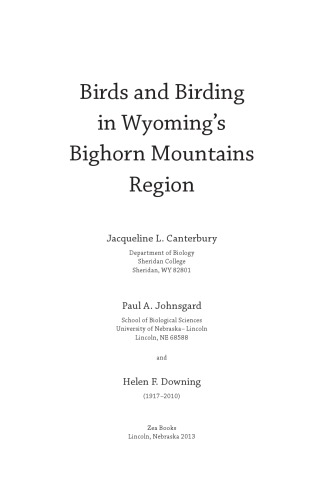Product desciption
Birds And Birding In Wyomings Bighorn Mountains Region Jacqueline L Canterbury by Jacqueline L. Canterbury, Paul A, Johnsgard, Helen F. Downing 9781609620417, 1609620410 instant download after payment.
The Bighorn Mountains consist of a relatively well-isolated north-south mountain range in north-central Wyoming that had their origins during the early Cenozoic era, 50-65 million years ago. The present-day Bighorn range is more than 100 miles in length and has a maximum elevation of 13,167 feet (Cloud Peak), only slightly less than the highest peak in Wyoming (Gannett Peak, at 13,804 feet). The mountains are flanked to the west by the Bighorn River basin, and to the east by the Powder River basin, both of which support only semi-desert vegetation dominated by sagebrush. Elevations of the Powder River basin near the Montana border and the Bighorn River near Worland are below 3,700 feet, and annual precipitation at Worland averages less than ten inches annually. The nearly 10,000-foot range of regional elevations and associated climate variations have produced a wide variation of terrestrial vegetation types. The mountains are still largely covered with native grasslands and mostly coniferous forest vegetation, the latter ranging from juniper scrub at low altitudes through ponderosa and lodgepole pines at middle elevations, to subalpine fir, Engelmann spruce and limber pine transitional to alpine tundra, which begins at 9,800–11,400 feet. Most of the still-forested areas lie within the 1.1 million-acre Bighorn National Forest.
We defined the Bighorn region as encompassing or about 6,800 square miles (latilong blocks 4 and 5), and determined that at least 327 bird species have been reliably reported from the region, plus 15 species of hypothetical status. This compared with a total of 427 species reported for all of Wyoming as of 2010 (Faulkner, 2010). Breeding within the region has been confirmed for 190 species. Among the breeders, 77 species have breeding ranges that were classified as to having an either clearly eastern-oriented or western-oriented affinity in North America. Of these, 55 (71 percent) were judged to be western-oriented and 22 (29 percent) eastern-oriented, indicating that the strongest zoogeographic affinities of Bighorn region birds are with western North America.
Species descriptions indicate relative abundance, breeding status by latilong, locality/date records for rarer species, and other relevant information. Many regional birding areas are described and mapped, and results of recent regional breeding bird surveys and seasonal bird counts are summarized. Line drawings illustrate representatives of each of the 53 avian families documented for the region, and there are more than 60 literature citations.


